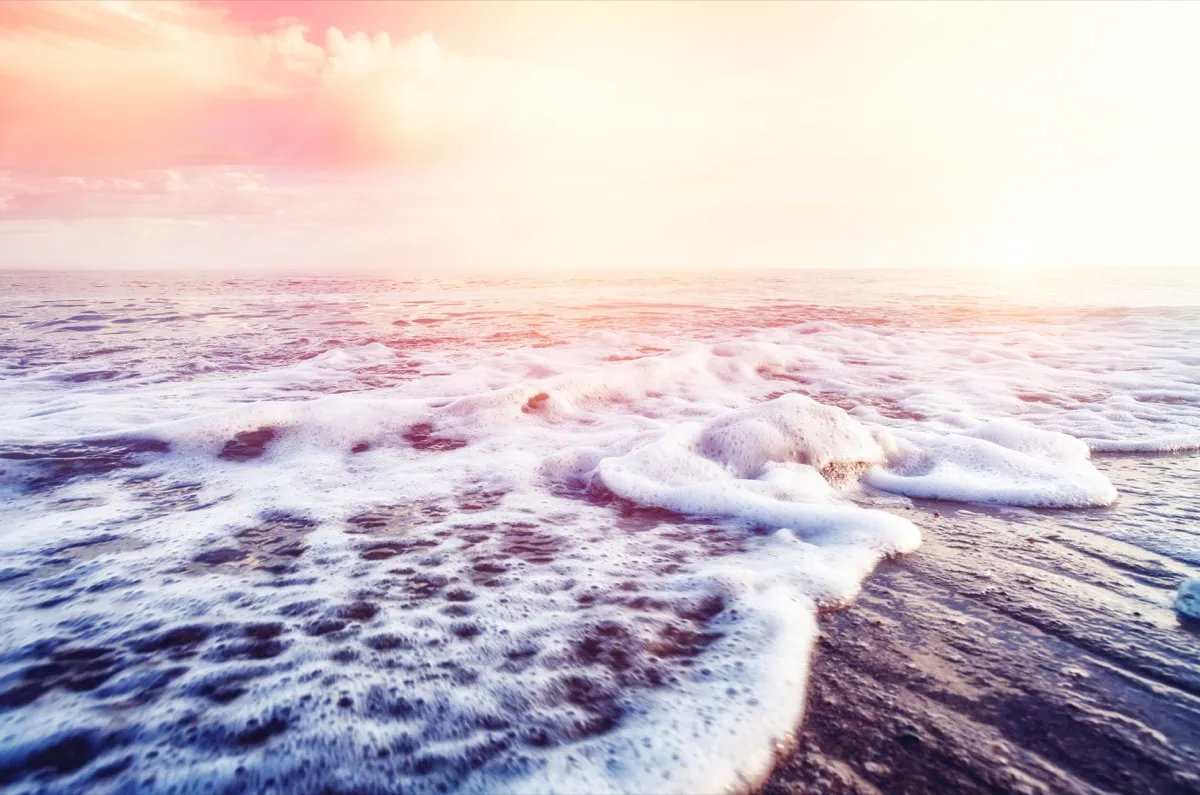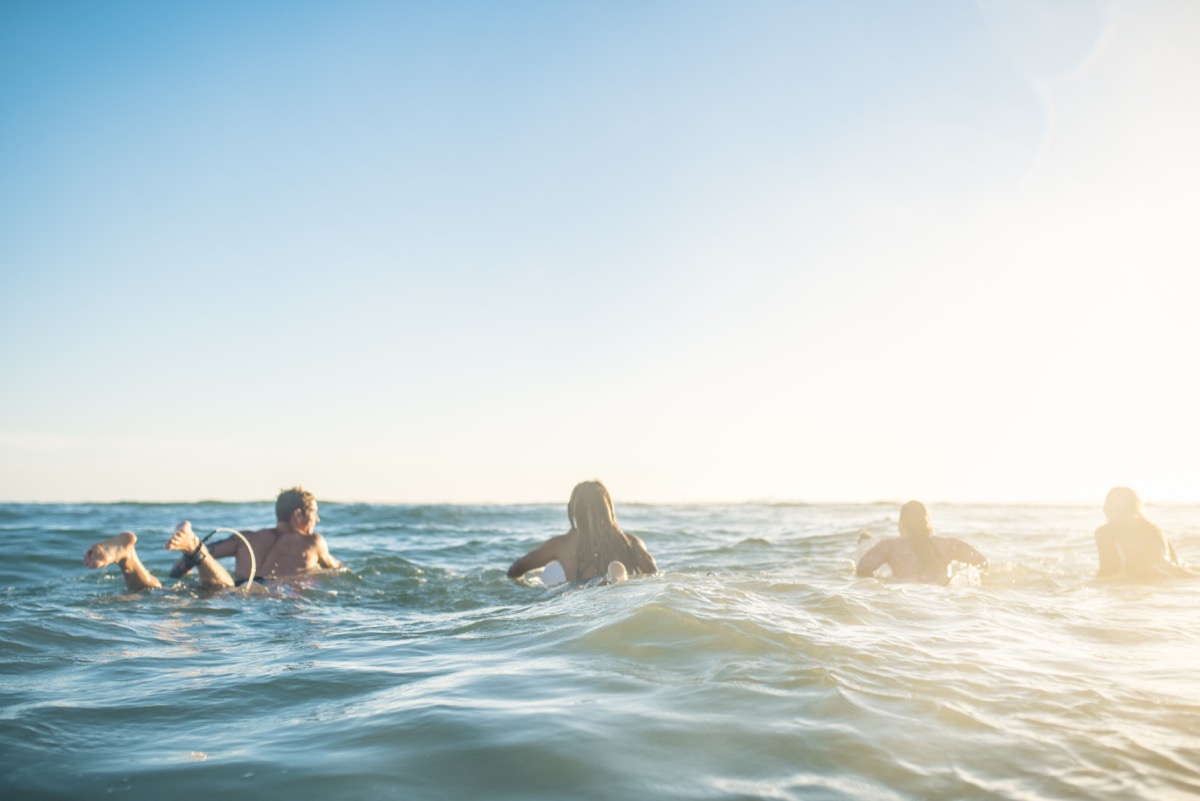If You Notice This at the Beach, Stay Out of the Water, Experts Warn
You should avoid taking a dip whenever you can see this one thing.
Whether you live near the coast or you're taking an annual family trip, the return of summer also means that beach season is back. Besides relaxing in the sand with a great book or walking along waves in search of shells, it's also a great way to beat the heat by taking a dip in the ocean. But many fans of the shore may not realize that certain conditions can make taking a swim an extremely dangerous activity—even when the weather appears to be pristine. And according to experts, you should always stay out of the water if you notice one key sign at the beach. Read on to see what's the biggest clue that you should stick to dry land.
READ THIS NEXT: Never Go in a Lake If You See This One Thing, Local Officials Warn.
You should avoid the ocean entirely if you've recently done one thing.

Everyone knows that keeping an eye on adverse conditions is key to avoiding potentially dangerous swimming situations. But besides what nature may be doing at the moment, experts warn that one completely invisible hazard could pose a serious health threat if you enter the ocean.
In a June 22 interview with NBC-affiliate KPLC in Cameron Parish, Louisiana, Stephen Castleberry, MD, a general surgeon at West Calcasieu Cameron Hospital in Sulphur, Louisiana, warned that the dangerous Vibrio vulnificus bacteria has appeared on beaches more than a month earlier than usual. Unfortunately, this puts anyone with "any break in the skin, even a several-day-old tattoo [or] a small cut that you may not even recognize beforehand" at risk of a potentially fatal infection. Data from the Centers for Disease Control and Prevention (CDC) cautions that the bacteria can lead to a trip to intensive care, limb amputations, or even "life-threatening wound infections" that ultimately can kill roughly one in five people "sometimes within a day or two of becoming ill."
Because of this unseen danger, Castleberry warns that those with fresh wounds—including a new tattoo—should stick to the sand until their skin is completely healed. But besides your own body's conditions, experts caution there's another critical piece of evidence that you should avoid diving into the waves.
Experts warn that spotting one condition at the beach means you should stay out of the water.

Anyone who's had a beach day ruined by treacherous surf knows that ocean conditions can still be rough even when the air is warm and the sky is clear. But if you ever arrive to find that sets of waves have formed a square pattern as they approach the shore, experts warn that you should stay out of the water due to the danger they present to swimmers and boats, Travel + Leisure reports.
RELATED: For more up-to-date information, sign up for our daily newsletter.
The eye-catching wave pattern can make it difficult to swim or boat safely.

While the natural phenomenon of square waves may create a beautiful view or make for a stunning photograph, the checkerboard pattern is actually a sign of danger. According to HowStuffWorks, the conditions form when systems of ocean waves caused by wind collide with waves caused by a new weather system in what's known as "cross seas." This intermingling of moving water can cause powerful swells that can reach over 10 feet high that can overwhelm swimmers as well as boats or floatation devices. They can also generate strong rip currents, posing a serious safety hazard to anyone in the water.
Research has also found that the pattern can spell trouble for those in the ocean. In 2010, the European Space Agency called the conditions "quite common in the ocean," citing a 2004 study that found it was responsible for "a large percentage of ship accidents" in open waters. However, the agency also warned that "cross seas also often occur in the coastal regions." In fact, the sight of square waves is actually a draw for tourists in areas such as Île de Ré off the western coast of France, where they are viewed safely from the shore, Travel + Leisure reports.
Here's what you should do if you ever find yourself in dangerous ocean conditions.

While square waves may be one visual cue that you should avoid getting in the water, other dangerous conditions might not be as easy to spot. In fact, swimmers may only notice hazards such as rip currents once they've entered the water and are pulled further from shore. In 2019, a report published in Natural Hazards and Earth System Sciences found that the relatively invisible ocean hazard was responsible for 100 deaths in the U.S. each year and linked to 80 percent of lifeguard rescues, per the United States Lifesaving Association (USLA).
Even though they can be hard to spot, the USLA says that "churning, choppy water" and "a line of foam, seaweed or debris moving seaward" can be one key indicator that it's unsafe to dive into the surf. You might also spot them if you notice darker colored water, fewer waves, and a rippled surface surrounded by smoother water, per Australia's ABC News.
Those who find themselves caught in a rip current can still avoid making the situation worse by remaining calm and not trying to swim against the current back to shore, according to the National Park Service (NPS). Rather, you should swim parallel to the beach to exit the stream or tread water until the rip current dissipates before swimming back in at an angle. And if you're still struggling in the water, the NPS advises that you should face the shore, wave your hands, and signal for help.






















